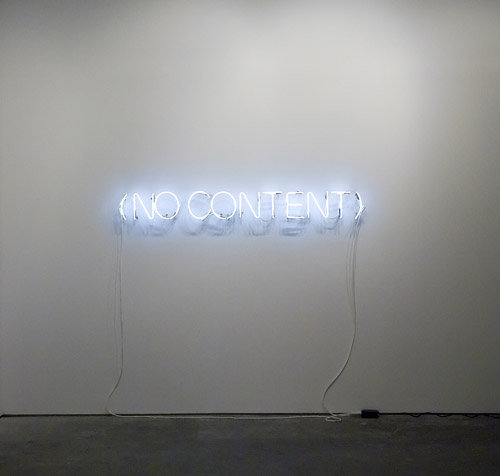Stefan Bruggemann
dal 1/11/2006 al 8/12/2006
Segnalato da
1/11/2006
Stefan Bruggemann
I-20 Gallery, New York
In this show, language becomes an inquiry. The works are neon texts, neon signs, inscribed objects and photographs. The minimal appearance of Bruggemann’s statements reduces description to a point of no return. He show us the hidden beauty and pleasure derived from the overlooked, and through his insistence on rendering visible, on giving form to what can only exist as a concept.

Solo exhibition
In this show, language becomes an inquiry. The works are neon texts, neon signs, inscribed objects and photographs.
The minimal appearance of Bruggemann’s statements reduces description to a point of no return. In works such as NO, NO, NO, NO there is a concern with reiteration, and the different color of the fourth and final NO compels the work forward. The words are picked out in white neon apart from the final one, spelled out in crimson. The negation thus drives the viewer towards its final utterance, suggesting a change of emphasis or terminal point: the end of nothing. We describe our existence by way of the experiences and things that are remarkable or salient; we celebrate what jars the norm or stands out from the ordinary, whilst ignoring and forgetting all that is commonplace and repetitive. Bruggemann reverses this preference, not by showing us the hidden beauty and pleasure derived from the overlooked, but through his insistence on rendering visible, on giving form to what can only exist as a concept.
Bruggemann abstracts neons for the first time in a new series Obliteration. The scribbled neon text is a gestural analogy to writing and un-writing. NOTHING, a stack of eponymously inscribed cardboard boxes, explores the idea of the void, or rather, as proposed by the French writer Georges Perec, what surrounds the void; the box then serves as a reminder of a space that is beyond our knowledge and powers of description. The body as a vessel is also not exempt from inquiry in this show. Bruggemann’s OFF, a photographic work, shows a selection of frames depicting the rear view of a woman in black against a black background. Her silhouette seen again and again is repetition subtly traced against the dark scenery and the slightest differences in the subject’s movement between the images is at the same time elusive and provocative. The accompanying book project for OFF will be released in early November.
Stefan Bruggemann was born in Mexico City in 1975 and lives and works in London. In 2006 he was nominated for the Beck’s Futures Prize with exhibitions at the Institute of Contemporary Arts, London, the Center for Contemporary Art, Glasgow, and the Arnolfini, Bristol. He has exhibited extensively, with 2006 group shows including Nichts (Nothing), Schirn Kunsthalle Frankfurt; Yes, Bruce Nauman, Zwirner & Wirth, New York; and Draw a straight line and follow it, the Center for Curatorial Studies at Bard College, Annendale on Hudson. Other shows include Off-Key, Kunsthalle Bern (2005); The Peaceful War, Tramway, Glasgow (2005); La Colmena, the Jumex Collection, Mexico City (2004); To be political it has to look nice, apexart, New York (2003); Prague Biennale 1 (2003); Zebra Crossing, Haus de Kulturen der Welt, Berlin (2002); and Opening, Museum of Installation, London (1998). Bruggemann was the inaugural exhibition for Blow de la Barra in London in 2005. He was the founder and director of the Programa Art Center in Mexico City, a non-profit exhibition space of works by artists from Mexico and abroad including Martin Creed and Thomas Demand. In 2007, his work will be included in Escultural Social: A New Generation of Art from Mexico City, at the Museum of Contemporary Art, Chicago. His recent book “Capitalism and Schizophrenia" was published by Turner.
Opening: November 2, 2006, 6-8PM
I-20 Gallery
557 West 23rd Street, New York 10011
open Tuesday through Saturday, 11 AM-6 PM.



